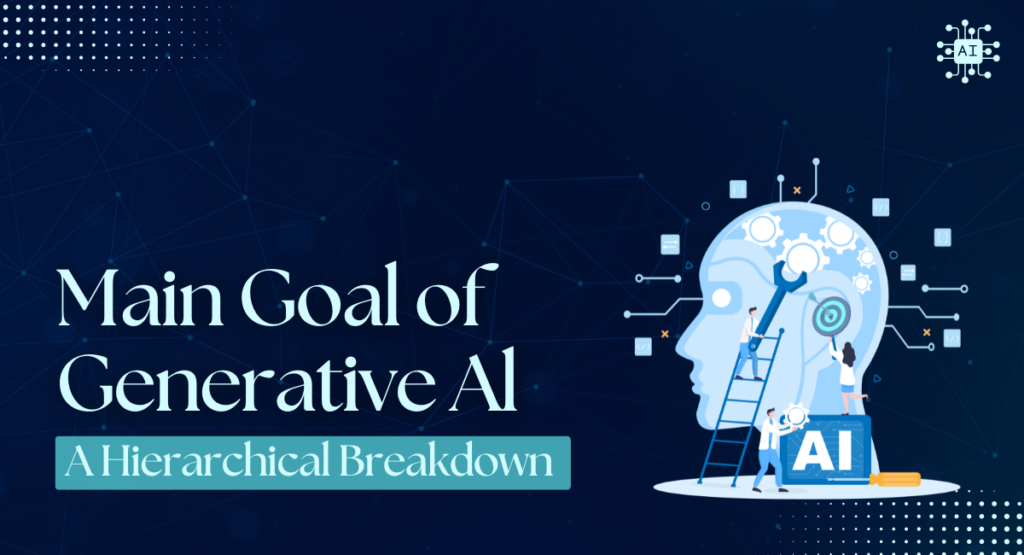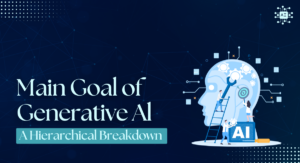Generative AI is a branch of AI. It transforms how businesses and industries operate.
Its ability to create new content and drive innovation is gaining momentum worldwide. Generative AI is now a valuable tool in many fields. It creates realistic images and writes articles. It’s used in content creation, healthcare, and education.
In this blog, we’ll examine what generative AI is, its core objective, and the main goal of Generative AI. We will also explore the hierarchy of AI, the pros and cons of generative AI, and its future.
What is Generative AI?
Generative AI refers to systems that use algorithms to create new data. This data mimics human-generated content. Unlike traditional AI, which analyzes data and gives outcomes, Generative AI creates. For instance, a traditional AI model might categorize a photo, while a Generative AI model can create a new image.
Key technologies include neural networks, transformers, and GANs (Generative Adversarial Networks). These allow the AI to generate human-like content based on learned patterns.
Understanding the Main Goal of Generative AI
The primary goal of Generative AI is to autonomously create new content that mirrors human creativity. This includes text, images, music, and more.
The key focus is innovation—generating content without human input once the AI is trained. It seeks autonomy, contrasting with traditional AI models that rely on analyzing existing data to produce insights.
Here are the key points outlining this goal:
- Autonomously Create New Content:
- The core goal of Generative AI is to generate new, original content (text, images, music, etc.) without requiring human intervention.
- It mimics human creativity by learning from existing data to produce new outputs.
- Focus on Creativity and Innovation:
- Unlike traditional AI, which primarily analyzes or categorizes data, Generative AI strives to innovate.
- It doesn’t just use data to make decisions but creates new content, pushing the boundaries of what’s possible in automation.
- Simulating Human-like Content:
- The AI’sAI aims to produce content that closely resembles human-generated work, whether it’s written text, art, or even musical compositions.
- The result should be realistic enough to be indistinguishable from human-created content.
- Autonomy in Content Generation:
- Generative AI’s key strength is the ability to operate independently. Once trained, it can produce content on its own without the need for continuous input.
- This autonomy is particularly useful in marketing, content creation, and design industries.
This structured explanation provides a clear understanding of the main goal of Generative AI, emphasizing its focus on creating new content, its innovative approach, and how it differs from traditional AI.
How Generative AI Works & Uses Technologies
Generative AI relies on advanced machine learning techniques and neural networks to function. Some of the key technologies involved include:
Generative Adversarial Networks (GANs):
These models consist of two competing neural networks, generating content and evaluating its quality.
Variational Autoencoders (VAEs):
Used to generate new data points by learning latent spaces in the dataset.
Diffusion Models:
These models help transform one form of data into another, such as transforming text prompts into images.
By using these advanced methods, Generative AI trains itself to recognize patterns and create realistic outputs autonomously.
Hierarchical Relationship Between AI, ML, DL, and Generative AI
This structure helps to place Generative AI in the wider AI ecosystem. It shows its key role in innovation and content creation.
To understand generative AI fully, it’s important to recognize its position within the broader AI hierarchy:
- Artificial Intelligence (AI): The idea that machines can do tasks that need human intelligence.
- Machine Learning (ML): A subset of AI focused on learning from data to make predictions or decisions.
- Deep Learning (DL): A more specialized part of ML that uses neural networks to solve complex problems.
- Generative AI (Gen AI): A unique subset of DL designed to generate new content, taking AI’s capabilities further.
Applications of Generative AI
Generative AI has various applications, transforming various industries by automating creative and analytical tasks.
Generative AI has wide-ranging applications across industries:
- Creative Industries: Artists, musicians, and writers use AI to generate new works. AI-generated art makes waves in the design world, while musicians use AI to compose melodies.
- Healthcare: In drug discovery, AI generates new chemical compounds that could lead to groundbreaking treatments. AI also creates more efficient imaging solutions for medical professionals.
- Business: Companies leverage Generative AI for personalized marketing content, automating customer engagement, and developing innovative product designs.
- Education: AI personalizes learning experiences by generating tailored content for students, improving engagement and educational outcomes.
These applications are only the beginning as generative AI’s capabilities expand.
Challenges in Achieving the Goal
While Generative AI has transformative potential, it faces several challenges:
- Ethical Concerns: AI-generated content, particularly deepfakes, can be used maliciously, raising ethical questions about its use.
- Data Privacy: As AI models require vast amounts of data, concerns about user privacy and consent continue to grow.
- Accuracy: AI-generated content is not always reliable, and human oversight is required to ensure the quality and truthfulness of the output.
- Job Displacement: As AI takes on more creative tasks, concerns about its impact on human employment in creative fields are valid.
- Bias in Data: If training data is biased, the AI output will also reflect that bias, leading to unfair or inaccurate results.
- Resource-Intensive: Training large generative models requires significant computational power and energy, which can be costly.
Addressing these challenges will be crucial for generative AI’s continued growth.
Benefits and Limitations of Generative AI
Generative AI is a powerful technology with important benefits and clear limitations.
Here’s a straightforward look at these aspects.
Benefits of Generative AI
- Innovation: Generative AI opens new avenues for creativity and problem-solving, allowing industries to generate fresh ideas and products.
- Efficiency: Businesses and professionals can automate tasks like content generation, reducing time and effort.
- Scalability: With AI, businesses can scale operations without increasing human resources.
- Personalization: Enables the creation of personalized experiences, such as tailored marketing messages or customized product recommendations.
Limitations of Generative AI
- Ethical Concerns: As mentioned, misuse of AI-generated content can lead to harmful consequences.
- Data Privacy: AI’s need for extensive data can lead to privacy issues, requiring careful regulation.
- Bias: AI can generate biased outputs if trained on biased data, leading to concerns about fairness.
- Dependence on Data: Generative AI is only as good as the data it’s trained on, making high-quality, diverse datasets essential.
Future Directions for Generative AI
As Generative AI continues to evolve, researchers and practitioners are exploring various avenues to advance the field:
- Industry Impacts: AI will change industries, from entertainment to healthcare. It will offer new opportunities for innovation.
- Business Opportunities: Companies that harness the power of Generative AI will be responsible for content creation, automation, and personalized customer experiences.
- Creativity: AI may change our views on creativity. It could transform both solo and group art processes.
- Ethical Standards: As concerns about bias and ethics grow, we can expect stricter regulations and standards to ensure AI is used responsibly.
- Human-AI Collaboration: AI will assist, not replace, human creativity. It will be a tool to enhance human work in creative processes.
- Industry-Specific Applications: AI will create industry-specific apps. They will automate tasks and improve workflows.
Generative AI will advance in context-aware models, producing more accurate and creative outputs. It will expand into virtual reality, education, and enhanced content creation across industries.
Conclusion
Generative AI’s primary goal is to create human-like content, autonomously. It could revolutionize industries by innovating and automating. e. As we explore its capabilities further, its significance in shaping the future of creativity and technology becomes increasingly clear.
FAQs on Generative AI: Main Goal and Hierarchy
How does Generative AI differ from traditional AI?
Traditional AI focuses on recognizing patterns and making decisions based on data, while generative AI creates new content by learning patterns from data.
Can Generative AI replace human creativity?
While it can mimic human creativity, Generative AI is a tool that can assist in creative processes. However, it doesn’t fully replace human creativity, as it requires human oversight for quality and relevance
What are some examples of Generative AI tools?
Examples include OpenAI’s GPT-4 for text generation, DALL-E for image creation, and Google’s DeepDream for artistic visualizations.
What are the ethical concerns surrounding Generative AI?
The main concerns include data privacy, bias in generated content, and the potential misuse of AI for unethical purposes, such as spreading misinformation.
How can businesses leverage Generative AI effectively?
Businesses can use generative AI to automate content creation. It can also improve customer service with AI-generated responses. Finally, it can streamline data analysis tasks. This will boost efficiency and cut costs.


